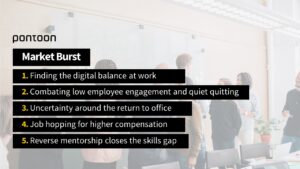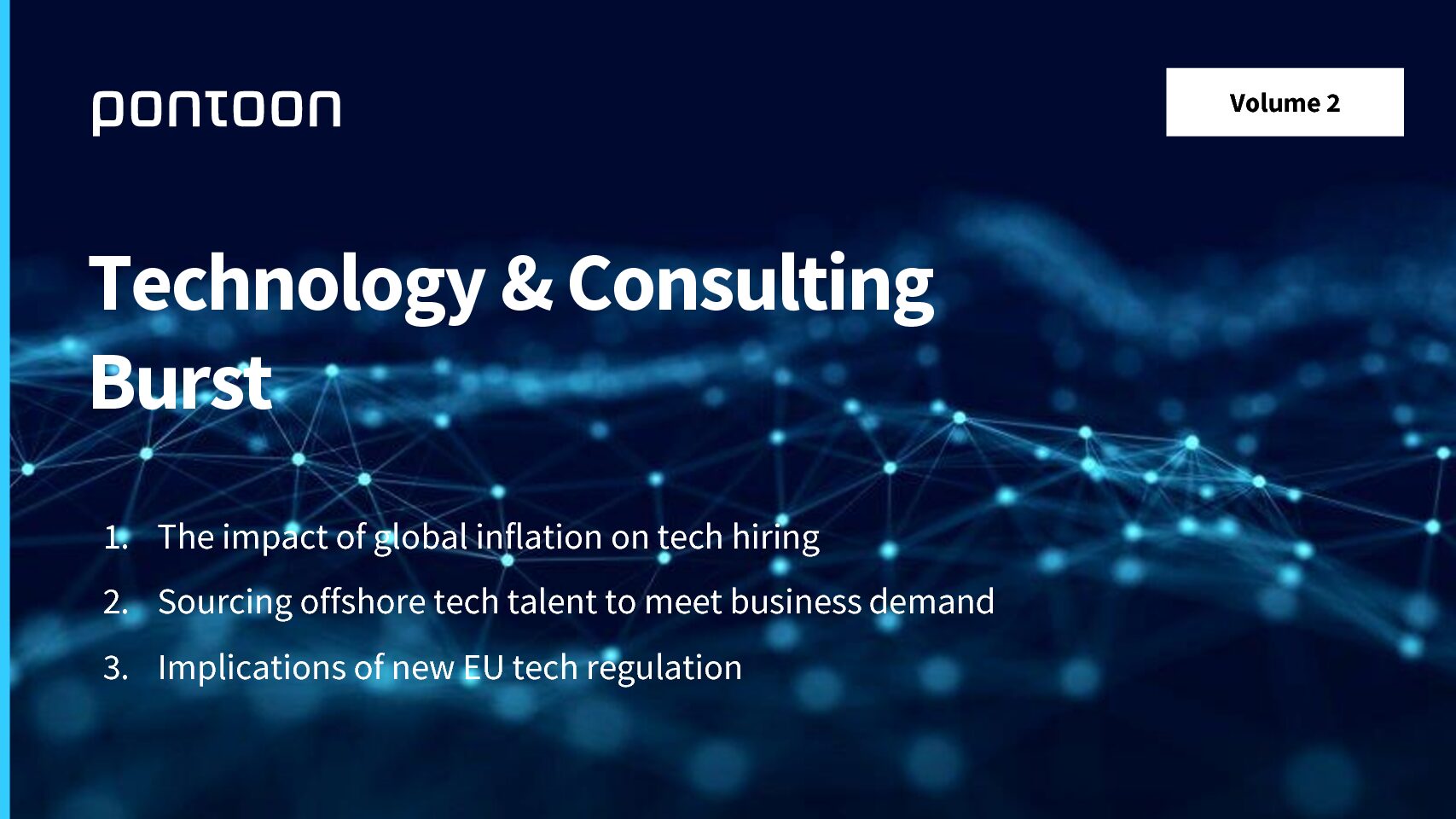Market Burst: September 2022
Read about top trends in the world of work.
Finding the digital balance at work
In the fully-remote and hybrid world of work, poor technology leads to a poor employee experience. Productivity suffers if communication channels break down and workers feel overwhelmed with all the available tech. It’s never been more critical for firms to streamline their tech stack to be user-friendly and accessible.
5 in 10 workers believe improving the digital employee experience should be a top priority for management, but only 20% of leaders see the need for these improvements. There is a clear misalignment between the actual tech needs of the current workforce and the executive perspective of employees’ digital prowess.
This divide becomes a reality with 4 in 10 individuals admitting that they’ve considered leaving their workplace because of poor digital experience — and 14% already have.
One solution is to deploy tech geared towards an optimal employee experience, such as Applaud or Microsoft Viva. These create an additional layer between the core HR systems and productivity tools like Zoom and Microsoft Teams. Some companies embrace this approach to tie together all the disparate technologies available across their businesses which eases the tracking and usability of tools for their people.
Combating low employee engagement and quiet quitting
With only 21% of global workers feeling engaged, it comes as no surprise that most workers worldwide spend their weeks watching the clock tick. Low engagement rates and post-pandemic dissatisfaction with hustle culture are the driving factors behind ghost quitting, otherwise known as quiet quitting.
The phenomenon denotes a practice in which a worker does just enough to get by but has mentally and emotionally checked out from their role. With hiring freezes and soaring inflation, quitting is a risky business – that’s why many prefer to stay put and do the bare minimum as they wait for a better opportunity to come by. Quiet quitting has also been linked to a new “lying flat” movement, associated with young Chinese professionals who rebel against the culture of overwork in China.
What can be done about ghost quitters? Apart from creating a work culture full of meaning and purpose, it’s also worth checking in with your existing workforce. An honest conversation with a manager can help current employees find a new, perhaps more challenging role within – rather than outside – the business, making them feel appreciated and fulfilled.
Uncertainty around the return to office
With the Covid-19 pandemic being an unpredictable flux, designing a logical work strategy has been a challenge for businesses across the world. With no clear guidance and inconsistent communication, employees are experiencing an unnerving state of uncertainty. A mandatory return to the office can also spark controversies. Apple’s recent decision to implement a three-day-per-week policy has already raised concerns, leading to a workers’ petition against the RTO mandate.
Return-to-office policies can put people in precarious positions, causing a major disruption to their new routines. Resigning from at-home work setups already leads to stress and anxiety related to job location, costs and logistics of commute, changes in housework responsibilities and more. Even going back to official business dress code might be an issue. While some employees are happy to again glam up for a day at the office, others are reluctant to give up the comfort of their home attires. For instance, 34% of Millennials in Australia would quit their jobs if their employer forced them to dress formally again.
Since opinions on hybrid, remote, and onsite working conditions tend to vary and – some experts herald the end of remote work, others proclaim the death of the office – there is no one single right answer. Companies must listen, engage and incorporate their workforces’ needs and preferences before decisions are made.
Job hopping for higher compensation
In the current employment market, new hires are often paid more due to changing market conditions while the compensation of existing employees remains the same. Considering current inflation and soaring prices, earning more money from the competition is tempting. While staying in the same job means security, consistency and the potential for future advancement in a stable environment, workers are willing to risk it for pay that keeps up with the current market conditions.
The UK Office for National Statistics (ONS) data shows that the average hourly earnings growth in the UK between 2012 and 2021 was 6.6% higher for people who had changed employers. Job hoppers aged 16 to 24 made the most significant salary gains of 20%. In the US, nearly a third of professionals who left their organisation during the pandemic make over 30% more than they did in their previous job, reports Conference Board.
Many employers are revisiting their compensation strategies to address the current salary expectations. Even with competitive total reward packages, CHROs encounter aggressive salary negotiations from job candidates and their existing workers. In response, many are offering more extensive equity offerings and sign-on bonuses. Some HR executives argue, however, that bonuses could have diminishing returns for top performers, who might prefer an increase to their starting salary. When it comes to merit-based raises, many CHROs look more closely at employee performance ratings to determine where they can afford to offer above-market raises. From there, they’re leaving it up to the managers to choose how to distribute the pay increases.
Reverse mentorship closes the skills gap
Establishing a culture of career-long learning remains crucial in narrowing the current digital skills divide. Many organisations are reimagining their internal mentorship programmes to adapt upskilling and reskilling to the new world of work. They are designing innovative learning approaches, one example being reverse mentoring.
This strategy encourages employees to form mutually beneficial workplace fellowships, regardless of seniority or time in the role. It helps close generational and digital gaps, improve morale and increase opinion diversity. Additionally, as learning and growth are never one-sided, new team members can share different perspectives on current business challenges, while long-serving colleagues support newcomers navigating organisational complexities.
Firms like Johnson & Johnson and Estee Lauder have succeeded with reverse mentoring programmes, with the latter citing a positive experience for 88% of their senior leaders. Companies willing to try a similar approach must first understand where their skill gaps exist to define programme goals and expectations. Support with pairing colleagues of different skill sets and experiences comes next, followed by setting clear goals and boundaries for these internal conversations.
Related Post
How is global inflation impacting hiring tech talent?
Why is sourcing offshore a popular option for many organisations, and where to find the tech talent?
How are the new EU tech regulations ...





